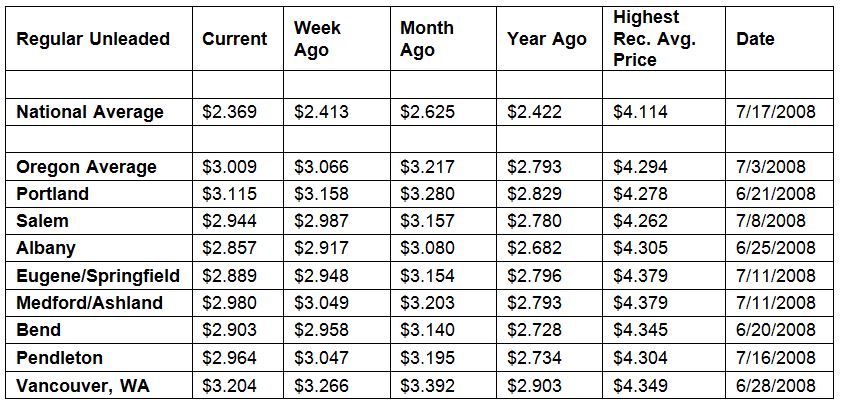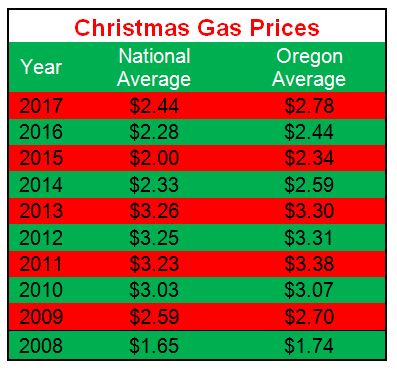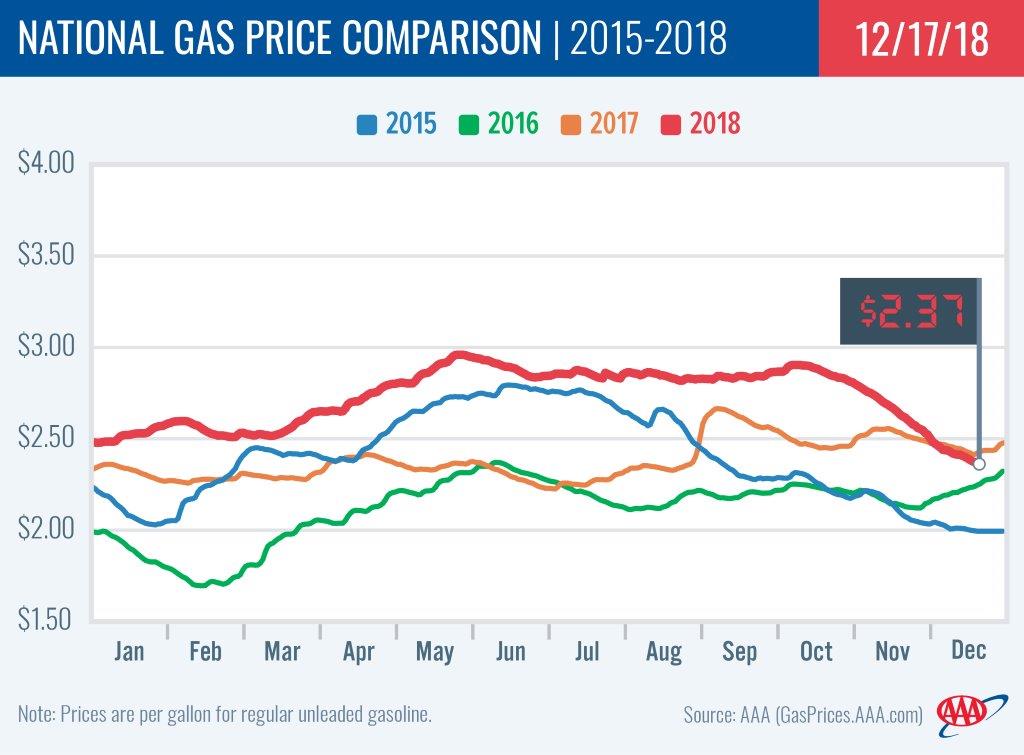PORTLAND, Ore., – It’s a merry forecast for holiday pump prices as millions of Americans hit the road for Christmas and New Year’s Day. Prices are lower in all 50 states this week. The national average for regular drops four cents to $2.37, the lowest price of the year so far and the cheapest price since August 2017. The Oregon average falls six cents to $3.01, the lowest price since last March. Many Oregon markets have averages below $3 a gallon.
With gasoline production on the high side – 10 million b/d – amid low demand, drivers can expect gas prices to keep falling through the end of the year.
That’s welcome news for the record number of holiday travelers this year. AAA projects more than 112.5 million Americans (33 percent of the population) will travel for the Christmas and New Year holidays. This is the most on record and a 4.4 percent increase compared to last year. In Oregon, roughly 1.37 million will travel.
“About 91 percent of holiday travelers plan to drive to their destinations with cheaper pump prices fueling their decision to hit the road,” says Marie Dodds, public affairs director for AAA Oregon/Idaho.
Find details in the AAA holiday travel news release.
All 50 states and the District of Columbia are reporting lower gas prices week-over-week. Idaho (-10 cents) has the largest drop, while Delaware (-1/2 cent) has the smallest.
All 50 states and the District of Columbia are showing double-digit drops in the last month. The national average is 26 cents less and the Oregon average is 21 cents less than a month ago. Arkansas (-35 cents) has the largest monthly decrease. Delaware (-12 cents) has the smallest monthly decrease.
The West Coast continues to have the most expensive gas prices in the nation. Hawaii tops the list for the 28th week in a row with California, Washington, Alaska, Nevada, and Oregon rounding out the top six. Oregon is sixth most expensive for the fifth week in a row. On the week, Hawaii (-9 cents) has the largest drop in the region.
The U.S. Energy Information Administration’s (EIA) weekly petroleum status report for the week ending December 7 shows West Coast gasoline stocks increased by approximately 600,000 bbl to 28.3 million bbl. Stocks are approximately 2.4 million bbl lower than at this time last year, which could cause prices to spike if there is a supply challenge in the region this week.
The nation’s cheapest markets are Missouri ($1.96) and South Carolina ($2.03). This is the second week in a row that a state has an average below $2 a gallon.
Oregon is one of 16 states where drivers are paying more than a year ago to fill up. The national average is five cents less and the Oregon average is 22 cents more than a year ago. This is the ninth-largest yearly increase in the country. Arizona (+37 cents) has the greatest year-over-year increase; Nevada (+36 cents) is second; California (+31 cents) is third; Utah (+29 cents) is fourth; and Wyoming (+28 cents) is fifth.
Oil Market Dynamics
Oil prices mostly fell last week as market observers continue to worry that the global crude market is oversupplied. Although the Organization of the Petroleum Exporting Countries (OPEC) and other oil producers, including Russia, agreed last week to reduce output by 1.2 million barrels per day at the beginning of 2019, crude prices will likely remain low until the production reduction agreement is in place.
Here in the U.S., total domestic crude inventories are continuing to slide. Crude inventories around the country fell by 1.2 million bbl, according to the latest data released by EIA. Stocks now total 442 million bbl, which is approximately 1 million bbl lower than where they were at this time last year. With domestic inventories falling and OPEC’s production reduction agreement set to take effect in early 2019, crude prices are poised to increase early next year which would put upward pressure on pump prices.
At the close of Friday’s formal trading session on the NYMEX, WTI decreased $1.38 to settle at $51.20. At the close of Monday’s formal trading session on the NYMEX, WTI fell $1.32 to settle at $49.88. Today crude is trading around $47, compared to $52 a week ago. Crude prices are down about 17 percent in the last month and are about $1 per barrel lower than a year ago.
Drivers can find current gas prices along their route with the free AAA Mobile app for iPhone, iPad and Android. The app can also be used to map a route, find discounts, book a hotel and access AAA roadside assistance. Learn more at AAA.com/mobile.
Diesel
For the week, the national average falls four cents to $3.07 a gallon. Oregon’s average drops a nickel to $3.23. A year ago the national average for diesel was $2.83 and the Oregon average was $3.00.
Find current fuel prices at GasPrices.AAA.com.
AAA news releases, high resolution images, broadcast-quality video, fact sheets and podcasts are available on the AAA NewsRoom at NewsRoom.AAA.com.




